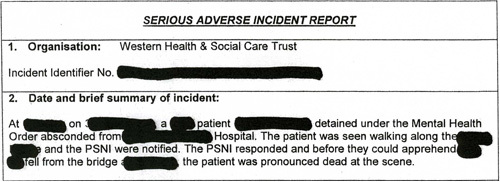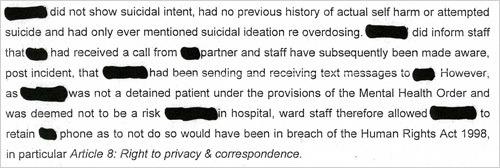Serious adverse incident forms released by the Department of Health and covering the period May 2009-April 2010:
BELFAST HEALTH AND CARE TRUST:
• Patient was discovered dead in his home. He was an inpatient and diagnosed as suffering from a depressive illness. He had no previous psychiatric history and was a voluntary patient. He had had two previous day passes and on this occasion had been again out on pass from hospital. He failed to return as arranged so the Absent Without Leave procedure was implemented and the police notified at 11.15pm. Police contacted the ward at 9.45am (no date specified) to indicate that the patient had been discovered dead at his home address.
• 2008: person is believed to have attempted to harm themself by hanging at their home. Sex of person unclear. Was discovered in the garage of the family home. Taken to hospital by ambulance and remains in intensive care with life support. The person and their sister have been known to Social Services since October 2005 – referred by family GP for family support re. behaviour management. The Family trauma centre and child adolescent mental health services became involved. In 2008 the person was referred to crisis management and intervention team from hospital with first presentation of self harm. Was remorseful and future thinking. Patient last seen by (blacked out) two hours prior to being found. Had seen a field social worker two days before. Staff had no concerns regarding the patient.
• Sudden death of a (blacked out) found hanging in his own flat in a mental health supported housing scheme. The client was known to mental health services. Conclusions and recommendations from multidisciplinary review were included with the SAI report. This stated that the person had appropriate support from mental health care services and from his family. Prior to his sudden death there did not appear to be any indication that his mental health was deteriorating or that he had any thoughts of life not worth living. Records show that his mental state was improving, he co-operated well with services and socially he was enjoying his FE college course and independent living in his flat. It would appear that there was nothing more that could have been done to prevent his death.
• Man seen by liaison psychiatry is reported to have taken his own life, three days after discharge from (blacked out). Minutes provided of Patient Safety Incident Meeting in August 2008 at Mater Hospital. The man was known to Mental Health Services and presumed to have taken his own life by hanging. The incident was reported anonymously by telephone. He had been admitted to the Royal Victoria Hospital from A&E following a serious and violent self-harm episode. Medical notes written just after he was admitted state: “Patient states that he had 3 pints of beer today and intends to kill himself when discharged from hospital”. Notes also refer to relationship issues. “Patient not remorseful, if released will ‘do the job properly this pm.”
Following surgery he was considered medically fit for discharge and was to stay with his sister. Recommendations noted in his chart were that he should start antidepressants and to contact Relate and GP to make referrals to community outreach team following discharge. On (blacked out) a nurse received a call from a distressed female asking who had decided to discharge him. “She then told me that he had hanged himself and wanted to let us know that he shouldn’t have been discharged. She then hung up.” Under the heading ‘Psychiatric Liaison Service’ the report states that during his hospital admission he would have intermittent thoughts of life not being worth living and that he wished the suicidal attempt had been successful. However, he also stated that he was very remorseful and guilty over what he had done and his mood had improved. He had previous history of an overdose 3/4 years ago but no previous mental health contact and no known mental illness. The GP was unable to confirm if the patient had been seen since discharge as he was not able to access his notes (the police had removed records for the coroner). Among the five points of ‘learning and recommendations’ was that the trust should explore ways for patients to have a psychiatric outpatients appointment prior to discharge.
• Patient known to the health visiting service committed suicide 12 weeks after giving birth. The health visitor visited on three occasions, there were also five no access visits to the home. On last visit completed the Edinburgh Post Natal Depression Score and got 11 (considered borderline for probable post-natal depression). The health visitor advised them to see their GP and arranged to visit again on December 13th. Visited on (date blacked out) but no reply. Was informed that patient had committed suicide. The SAI form says that a case review will be carried out by the trust. The lady was not known to mental health service. The health visitor’s last visit was when was nine weeks after birth. The investigating team concluded that this was a tragic event which could not have been foreseen.
SOUTH EASTERN HEALTH AND SOCIAL CARE TRUST:
• Man was admitted to A&E having taken an overdose of Mephedrone and cutting himself. He died in (blacked out). He was known to Mental Health Services (Addictions and Crisis Response and Home Treatment Team) and was recently referred to psychology. Also open to Probation Service. The SAI form says that a trust review will be carried out. No information on the review was released to The Detail.
• Suicide by hanging in a hospital. Was known to mental health services. Had a history of depression and had been admitted. Left contrary to advice four hours later and was scheduled to attend an appointment with mental health services. Attended A&E – diagnosis: deliberate self harm. Was admitted. Hanging incident occurred around 3am when it was noted the patient was not in their bed. Patient found in the bathroom. Transferred to intensive care unit but later died.
• Suicide in custody. Died when a patient in hospital wing. Was kept on life support until arrival of family. Had been returned to prison for (blacked out) six days previously. Had a long history of mental health problems and was being treated in the community. Also had an extensive prison history of mental health problems and was classed at the time of the incident as a Prison at Risk 1. An investigation underway by the Prison Ombudsman and a trust investigation also commenced.
WESTERN HEALTH AND SOCIAL CARE TRUST:
• A patient detained under the Mental health Order absconded from (blacked out) Hospital. The patient was seen walking along the (blacked out) and the PSNI were notified. The PSNI responded and before they could apprehend (blacked out) fell from the bridge. The patient was pronounced dead at the scene.
SOUTHERN HEALTH AND SOCIAL CARE TRUST:
• Attempted suicide by psychiatric inpatient during 24 hour care in February 2010. She attempted to asphyxiate herself in her room within the Psychaitric Unit. She was discovered by ward staff and died in the intensive care unit four days later. Section of SAI report under headline ‘recent contact with mental health services’ has been completely blacked out. Root Cause Analysis report totalling 19 pages included in information released to The Detail. Woman has been admitted to A&E because of family concerns that she was suicidal. She was referred to Liaison Psychiatry Services. She had been admitted to mental health facilities before and was seeing a counsellor privately since returning to Northern Ireland following the breakup of her relationship. She said she had lost all interest in life. Her family said they had been watching her 24 hours a day. It was felt that a period of assessment would be appropriate and the night co-ordinator arranged admission. Routine 15 minute observations were carried out. She was assessed as not being a risk to herself whilst in hospital and a low risk when at home. She was a voluntary patient. The night before the suicide attempt she told staff she was not coping at all. Denied thoughts of self harm but admitted openly contemplating overdosing when she felt overwhelmed. On the day of the incident she had breakfast and interacted with staff. She was accounted for at the 15 minute observational check at 9.30am. At 9.45am she could not be seen in her room. She was found hanging in her room. Report shows she had been asking for medication but consultant psychiatrist had advised against sedation during the day and urged her instead to “ventilate her feelings” with the staff. The report states that risk assessments and observations did not indicate that she was at immediate risk or had any attempt to take her own life.
The “impulsive suicidal action” in the hospital setting had not been predicted or foreseen.
Staff were aware that she had received a telephone call the evening before the incident from her partner telling her that the relationship was over for good. As she was not a detained patient, staff could not retain her phone.
NORTHERN HEALTH AND SOCIAL CARE TRUST:
• Sudden unexpected (blacked out) by hanging of an inpatient in the grounds of (blacked out). Minutes of multi-disciplinary review meeting – marked ‘strictly private and confidential’ – released to The Detail. Had been admitted on a voluntary basis. Presented with a history of (blacked out) and (blacked out) over several days. Had recently returned to work after being off because of an injury from a fall. Had found it difficult to settle back into work and became increasingly preoccupied with his financial situation. On admission was extremely agitated. Reported fleeting thoughts both of (blacked out) and of (blacked out). Shortly after admission was detained under the (blacked out). First interviewed by the consultant (blacked out) days after admission. He told the consultant that he expected to lose his home and go to prison because he could not pay his bills or debts. He was unable to give a rational explanation for these beliefs. He denied any thoughts of self-harm. “There was marked hopelessness about the future and therapeutic pessimism.” He became a voluntary patient and was allowed unsupervised time off the (blacked out). Started to feel better and went out on day pass with his family. He had gone out for a walk but did not return for lunch. Staff became concerned and checked were carried out of the building and then the grounds. Initial searches found nothing. The PSNI arrived to assist. His body was eventually discovered in a secluded area of vegetation near the main (blacked out) reception. It was evident that he had hanged (blacked out). There were no signs of life and resuscitation was impossible. The summary states that the consultant and nursing staff were shocked that he had taken his own life as all the indicators pointed to a gradual improvement in his condition. The recommendations included reviewing the current system of patients signing in and out.
TRUST UNKNOWN – REDACTED FROM SAI REPORT:
• Admitted to ICU following serious self harm incident (insulin overdose). Patient is not diabetic. SAI form says that they are an inpatient on general medical ward and seen by psychiatric liaison. Lots of DNAs (did not attend) for psychiatric outpatient appointments. One appointment also cancelled by the hospital. Also did not attend an addictions service appointment. Had been discharged from Community Mental Health Team. Psychiatric assessments indicate diagnosis of a dissocial personality disorder. When discharged, arrangements were made for review at Psychiatric Outpatients and also for a referral to the Addiction Services and Psychology.


